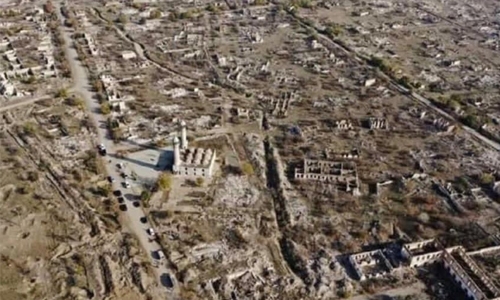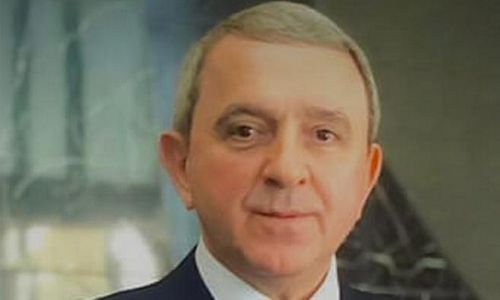Azerbaijan is restoring its territories liberated from Armenian occupation
After 44 days the Republic of Azerbaijan triumphed the war against Armenia which intentionally started cross border heavy shelling and bombardments on various civil populations and installations. It was almost 30 years that the negotiations to resolve the Nagorno-Karabakh conflict did not achieve its purpose because of periodic Armenian provocations. In late September 2020, however, with the successful military operations of the Azerbaijan Armed Forces, which resulted in Armenia's capitulation at the end, Azerbaijan was able to implement the UN Security Council Resolutions (822, 853, 874, 884) through liberating its territories under occupation. Undoubtedly, Azerbaijan's overwhelming military advantage induced the Armenian government to come to the negotiation table and finalize its illegal military presence within a neighboring sovereign state's boundary. So that on November 10, 2020, a major step has been taken towards the Nagorno-Karabakh conflict with the signing of a trilateral statement by Azerbaijan, Armenia, and Russia.
While the senior officials of Armenia were publicly declaring their defeat, Azerbaijanis were celebrating the victory on the streets of the capital Baku. For Azerbaijani side the trilateral agreement was continuation of the victory on the battlefield in diplomacy. Namely, the agreement comprised the unconditional withdrawal of the Armenian troops from the occupied territories within a definite schedule, the return of all refugees, and the deployment of the Russian peacekeepers in the several points of Nagorno-Karabakh. Furthermore, the cardinal element of the statement is that there was no word about the status of Nagorno-Karabakh.
After the active phase of the operations, when the footages were released from the liberated territories, it became apparent that Armenians vandalized massive cities during the occupation. Armenian barbarism in the residential areas was accompanied by the destruction of Azykh and Taghlar caves, "Qara kopek" and "Uzarlik" hill kurgans, first human settlements in the occupied territories and they were used for military purposes. Current state of the demolished cities evoked the images from Hiroshima. According to the latest data, 63 out of 67 mosques in Nagorno-Karabakh were totally destroyed, and 4 of them are majorly damaged. As a result of Armenian aggression, city of Aghdam became a ghost town, which was home to 150.000 Azerbaijanis before war. According to several organizations, during these years the overall loss of Azerbaijani economy is estimated as hundreds of billions of US dollars.
The barbaric acts were continued even after the trilateral statement signed on November 10. Ahead of the handover some Armenians leaving Kalbajar set their houses on fire. Besides, schools, cultural centers and other civilian objects are being burned; consequently, the public infrastructure is significantly damaged. Similar incidents have been observed in many parts of Nagorno-Karabakh. Recently, President Ilham Aliyev stated that foreign experts will be invited for the up-to-date calculations of the total damage resulting from occupation.
In pursuance of a trilateral statement signed by the presidents of Azerbaijan and Russia and the prime-minister of Armenia, units of Azerbaijani army entered Lachin district on December 1. Lachin district was kept under occupation by Armenian Armed Forces since May 18, 1992.
The conflict between two South Caucasus countries began in 1988 when Armenia made territorial claims against Azerbaijan. As a result of the ensuing war Armenian Armed Forces occupied 20 percent of Azerbaijan, including Nagorno-Karabakh region and seven surrounding districts. 1994 ceasefire agreement was followed by peace negotiations.
Azerbaijan restrained from it and responded Armenia on the battlefield. Not a single civilian Armenian killed during 6 weeks-long war. Not a single school, house, hospital or educational center was put under fire from Azerbaijan which showed its international commitment having superior human values.
At the same time villagers from outside Nagorno-Karabakh – Kalbajar, Lachin and Aghdam districts – set their homes and forests on fire, killed their cattle, cut down trees and power lines in order to destroy infrastructure before fleeing to Armenia ahead of a deadline that will see territories handed over to Azerbaijan as part of a peace agreement. Residents of those districts in Azerbaijan, which have been controlled by Armenian separatists for decades, began a mass exodus after it was announced that Azerbaijan would regain control.
By the total destruction of the settlements, Armenians aimed to prevent Azerbaijanis from a possible return. Nevertheless, Azerbaijan defeated Armenia both on the battlefield and at diplomatic arena. After Armenian side's capitulation, President Ilham Aliyev clearly pointed out that Azerbaijan will mobilize its economic potential to rebuild and revive Nagorno-Karabakh soon.
“The situation on the lands liberated from the occupation foreshadows great difficulties. There are currently no living conditions in these places. But we will restore these regions, all our districts, we will take all steps to create a normal life for our citizens,” said President Ilham Aliyev as he addressed the nation.
Noting that the first projects have already started, the head of state said: “The construction of the Fuzuli-Shusha highway and the Barda-Aghdam railway has already begun. This shows that we plan this work as efficiently as possible and, at the same time, in a short time, so that to organize all these activities without wasting time. Relevant state bodies have already been set up and all this work will be carried out in a coordinated manner.”
“The restoration of destroyed and ruined infrastructure, including the felled trees in Lachin, will also be in the spotlight, water reservoirs will be built. This in itself is one of the factors that will have a great impact on the development of agriculture and building an environmental equilibrium,” the President said.
“The overall economic, agricultural and tourism potential of all the liberated districts is great. We must maximize this potential and turn the Karabakh region into one of the most beautiful regions not only in Azerbaijan, but also in the world, and I am sure that we will achieve this,” President Ilham Aliyev added.
As the first step, it was reported that Azerbaijan Railways CJSC will be allocated $2.9 million from the state reserve fund for the design and construction of the Barda-Aghdam railway with a total length of 45 km. Afterwards, another major step was taken by the initiation of the construction of the new Fuzuli-Shusha highway. This highway will pass through liberated Fuzuli, Khojavand, and Khojaly districts, starting from the village of Ahmadbayli in Fuzuli district. Moreover, it will cover over 20 settlements in the regions, including Fuzuli and Shusha.
It will undoubtedly be a long path since the Armenians almost erased all the occupied Azerbaijani cities from the planet Earth. However, the speed of the new projects is enabling the rapid development of other infrastructure. The suitability of the region to a plethora of economic activities will orient the capital flow. All these factors indicate that in the short run, as President Ilham Aliyev said, "Karabakh will be reborn. It will be revived and reinvigorated. It will become a real paradise."
(The author is Shahin Abudllayev, Azerbaijan’s ambassador to Saudi Arabia)
Shahin Abdullayev, Azerbaijan's ambassador to Saudi Arabia
Related Posts


